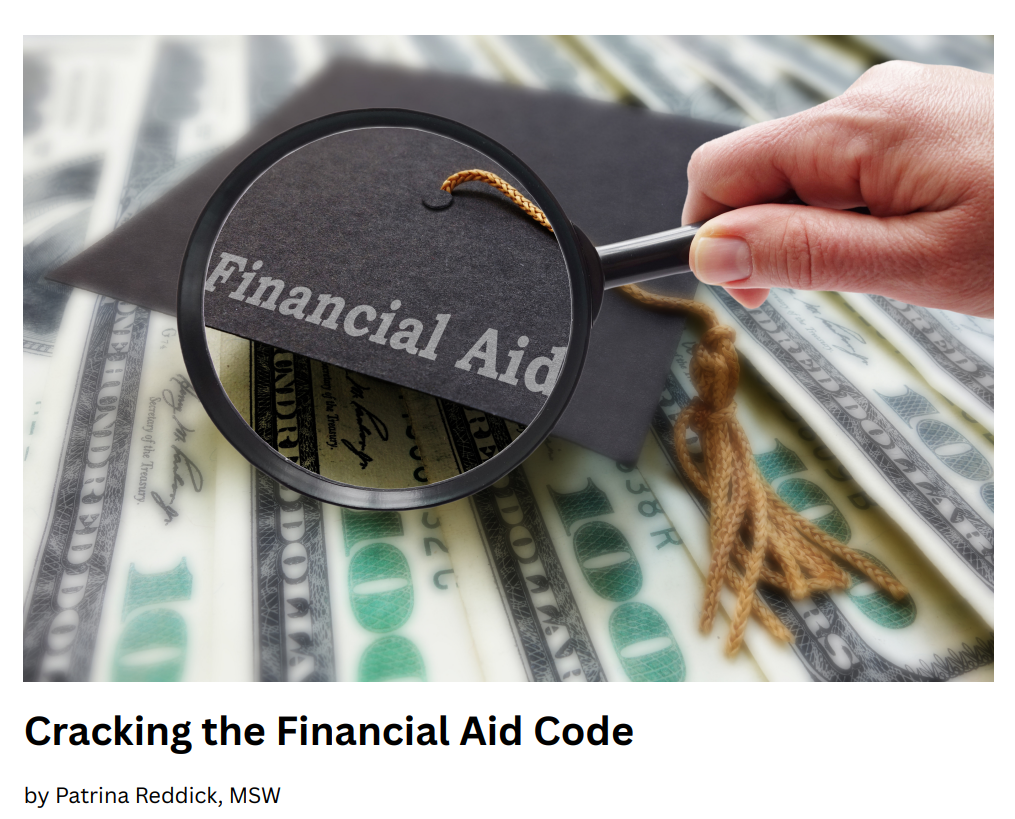
Financial aid is any funding that helps students pay for their education, such as grants, scholarships, loans, and work-study programs. Financial aid aims to make higher education more accessible to students who may not otherwise be able to afford it.
Many types of financial aid are available, and the eligibility requirements vary depending on the program. Grants and scholarships are typically awarded based on financial need, academic achievement, or a combination. Loans must be repaid with interest but usually offer more flexible repayment options than private loans. Work-study programs allow students to work part-time jobs on campus to earn money for their education.
Students must complete the Free Application for Federal Student Aid (FAFSA) to apply for financial aid. The FAFSA is used by the federal government, as well as many states and colleges, to determine a student’s eligibility for financial assistance. The FAFSA collects information about a student’s family income, assets, and other financial resources to calculate their Expected Family Contribution (EFC), which is the amount of money the student and their family are expected to contribute to their education.
It’s essential to apply for financial aid as early as possible, as some programs have limited funds distributed on a first-come, first-served basis. Students should also be aware of the various deadlines and requirements for each program they’re applying for and any renewal requirements for maintaining their eligibility for financial aid.
Financial aid can be a valuable resource for students pursuing higher education. Students can make informed decisions about financing their education and achieving their academic goals by understanding the types of financial aid available, the eligibility requirements, and the application process.
Federal FAFSA

The Free Application for Federal Student Aid (FAFSA) is a basic form that students must complete to receive federal financial aid for college. The FAFSA is a comprehensive application that collects information about the student’s income, assets, and family size, which is then used to calculate the student’s Expected Family Contribution (EFC). The EFC is the amount the student and their family are expected to contribute to college expenses.
Completing the FAFSA is a crucial step in the college application process that should be noticed. Filling out the FAFSA allows students to access federal financial aid programs, including grants, loans, and work-study programs. Additionally, many states and colleges use the FAFSA to determine eligibility for their financial aid programs.
Completing all necessary steps in the FAFSA process ensures students can access the maximum amount of financial aid available. This includes gathering all required personal and financial information, such as tax returns and bank statements, and submitting the FAFSA by the appropriate deadlines. Completing the FAFSA early is especially important, as some financial aid programs have limited funding and are awarded on a first-come, first-served basis.
It’s important to stress that completing the FAFSA does not guarantee that a student will receive financial aid. By completing the FAFSA and exploring other financial aid options, students can ensure that they are making the most of the resources available and set themselves up for success in their academic and professional lives. However, failing to apply to the FAFSA can result in missed opportunities for financial assistance that could make college more affordable.
Steps for completing the FAFSA:
- Gather essential documents: You will need your Social Security number, driver’s license or I.D. card, and your previous year’s tax returns (yours and your parents if you are a dependent student).
- Visit the FAFSA website: Go to fafsa.ed.gov to start the application process.
- Create an FSA ID: You must create a Federal Student Aid (FSA) I.D. as your digital signature for the FAFSA. You can create one at fsaid.ed.gov.
- Choose the appropriate FAFSA form: Select the proper FAFSA form based on the academic year you’re looking for financial aid.
- Fill out the application: Provide your personal and financial information as prompted, including income, assets, and family size. Please feel free to save your progress and return to the application later if you need to.
- Sign and submit the FAFSA: Review your application and electronically sign and submit it with your FSA ID.
- Review your Student Aid Report (SAR): After submitting your FAFSA, you will receive a SAR summarizing your information and confirming your EFC. Review it for accuracy and make any necessary corrections.
- Follow up with schools: The schools you applied to will receive your FAFSA information and use it to determine your eligibility for financial aid. Follow up with the schools to ensure they have all the necessary information and to explore other financial aid options.
Other things to remember when completing the FAFSA:

- Apply as early as possible: The FAFSA becomes available on October 1 each year, and some financial aid programs are awarded on a first-come, first-served basis. Applying as early as possible is essential to maximize your financial aid chances.
- Double-check your information: Ensure your personal and financial information is accurate before submitting your FAFSA. Errors can delay processing and potentially affect your eligibility for financial aid.
- Keep track of deadlines: Check the deadlines for the FAFSA and any state or college financial aid programs you may be eligible for. Missing a deadline could result in missed opportunities for financial assistance.
- Please get in touch with the financial aid office at your college or university of choice with any questions: If you have questions or concerns about the FAFSA or the financial assistance process, please don’t hesitate to contact the financial aid office at the school(s) you’re applying to. They can provide guidance and support to help you navigate the process.
Completing the FAFSA can be time-consuming, but it’s essential in accessing federal and state financial aid programs. By following these steps, you can ensure that you have completed the FAFSA accurately and submitted it on Time, increasing your chances of receiving financial aid to help you pay for college.
The FAFSA Deadline:

The FAFSA deadline varies depending on the state and the school you plan to attend. However, the federal deadline for submitting the FAFSA for the 2022-2023 academic year is June 30, 2023. I want to let you know that many states and colleges have deadlines earlier than the federal deadline, so it’s a good idea to check with the schools you’re interested in to determine their specific deadlines.
It’s also essential to submit the FAFSA as soon as possible after it becomes available on October 1, 2021, to maximize your eligibility for financial aid. Some financial aid programs have limited funds distributed on a first-come, first-served basis, so submitting the FAFSA early can increase your chances of receiving those funds.
In summary, while the federal deadline for submitting the FAFSA for the 2022-2023 academic year is June 30, 2023, it’s essential to check with the schools you’re interested in to find out their specific deadlines and to submit the FAFSA as early as possible to maximize your eligibility for financial aid.
Special Provisions for Children of Military Veterans

For children of military veterans, there are a few things to keep in mind:
- You may be eligible for additional financial aid: If your parent or guardian served in the military, you may qualify for further financial assistance through the Post-9/11 GI Bill or the Yellow Ribbon Program.
- You may be eligible for in-state tuition: Some states offer in-state tuition rates to children of military veterans, even if the student is not a resident of that state.
- You may be eligible for fee waivers: Some colleges and universities offer application or other fee waivers for children of military veterans.
For 100% disabled veterans, there are also special provisions:
- You may be eligible for additional financial aid: If your parent or guardian is a 100% disabled veteran, you may qualify for additional financial support through the Dependents’ Educational Assistance Program (DEA).
Things to keep in mind if you’re a child of a military veteran or a dependent of a 100% disabled veteran applying for financial aid through the FAFSA:
- Report untaxed income: If you or your parent received untaxed income through military allowances or other benefits, report them on the FAFSA. These may include housing allowances, combat pay, and basic allowance for subsistence (BAS).
- Report veteran status: On the FAFSA, you’ll be asked to report your parent’s veteran status. Be sure to answer this question accurately, as it can impact your eligibility for specific financial aid programs.
- Check for military scholarships: Many scholarships are available specifically for children of military veterans and dependents of 100% disabled veterans. Research these options and apply for any that you may be eligible for.
- Understand the impact of the Montgomery GI Bill: If your parent is using the Montgomery GI Bill to pay for your education, be aware that it may impact your eligibility for need-based financial aid. The GI Bill amount may be considered part of your family’s income when determining your financial aid package.
Considering these factors, you can ensure that you accurately report your family’s financial situation and take advantage of all available resources when applying for financial aid through the FAFSA.
If you are a child of a military veteran or a dependent of a 100% disabled veteran, it’s essential to research these options and speak with the financial aid office at the school(s) to which you’re applying. They can help you navigate the process and utilize all available resources.
Contact the FAFSA (Free Application for Federal Student Aid) Department in several ways:

- By phone: You can contact the Federal Student Aid Information Center at 1-800-4-FED-AID (1-800-433-3243) to speak with a customer service representative. The phone line is available Monday through Friday, 8 a.m. to 11 p.m. Eastern Time.
- By mail: You can send a letter to Federal Student Aid at the following address: Federal Student Aid Programs P.O. Box 7654 London, KY 40742-7654
- In-person: If you have a complex question or issue, you can schedule an appointment to meet with a financial aid advisor at a Federal Student Aid Information Center or your school’s financial assistance office. You can find the nearest Federal Student Aid Information Center by visiting https://studentaid.gov/help-center/contact and selecting “Find a Federal Student Aid Information Center.”
- Online: You can submit a question or request through the Federal Student Aid website’s online contact form. To access the form, go to https://studentaid.gov/help-center/contact and select your question’s appropriate category and subcategory.
In closing, it’s important to note that FAFSA is not a scholarship provider but rather a government agency that helps students and families apply for federal financial aid for college.
I hope this information is helpful to you; If so, let me know by leaving a message below. Thank you for reading, and all the best in your quest for higher learning without breaking the bank.

